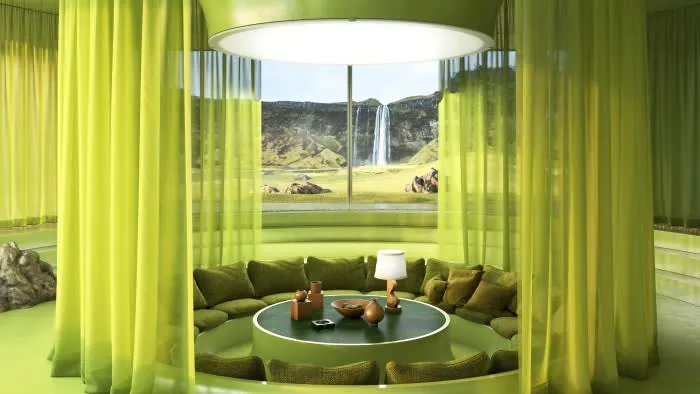
The Imaginative Future of Architecture: Exploring Hyperreality in Design
2024-10-12
Author: Daniel
The Captivation of Villa Saraceni
In a remarkable twist that has captivated the design world, artist and designer Charlotte Taylor collaborated with architect Riccardo Fornoni to create the stunning Villa Saraceni. Revealed in 2020, this sculptural, ocean-side masterpiece nestled in the iconic white cliffs of Scala dei Turchi, Sicily, generated unprecedented interest, going "semi-viral," as Taylor puts it. "We received countless requests for photoshoots and inquiries about rentals," she recalls, while Fornoni adds, "Some even reached out to complain about its presence at a UNESCO World Heritage site."
The Reality of Digital Creations
However, the reality is startling: Villa Saraceni doesn't exist in the tangible world. "It was a dream brought to life digitally," shares Fornoni, who operates from Mantua, Italy. The property exists solely as a Computer Generated Imagery (CGI) rendering—one emblematic of a broader trend where digital technology allows creatives to manifest escapist fantasies. Picture glossy glass structures hovering above serene waters and futuristic environments that provoke awe and curiosity through their surreal, yet strikingly photorealistic, portrayals.
Evolution of Rendering Technology
The application of rendering technology emerged in the 1970s and 1980s, with early examples including Zaha Hadid’s unbuilt high-rise design, "The Peak." Initially, renderings shared a stylized essence—a blend of dystopia and pristine visuals. Taylor critiques this norm, noting, "Often, spaces presented in these images appear void of life. I prefer to introduce a bit of chaos, something with character—perhaps even a Sudoku puzzle on the table."
The Potential of Virtual Spaces
Creating real furniture is labor-intensive and costly, prompting designers to leverage virtual spaces where ideas can be tested without high expenditures—something that both Taylor and Fornoni embrace.
Taylor’s Journey into Virtual Architecture
Taylor’s immersive approach emerged fortuitously while she was developing trompe l'oeil illustrations. The pandemic lockdown of 2020 sparked her fascination with rendering software, leading to the inception of her design studio, Maison de Sable. What began as singular scenes transformed into elaborate homes, with Taylor enthusiastically describing it as a liberating trial-and-error process.
Collaborative Projects and Innovation
Collaborative projects have flourished, such as The Residency, a pristine concrete haven inspired by Joshua Tree National Park, and Villa Ortizet—a surreal, avocado-green dwelling surrounded by the lush Lozère countryside, highlighted by a retro circular sunken sofa. Taylor also joined forces with French architect Nicholas Prèaud to envision Casa Atibaia, a curvilinear glass structure gracefully balancing atop boulders in São Paulo.
The Intersection of Digital and Reality
Despite their digital nature, Prèaud insists that each project is meticulously crafted with future construction in mind. "They're dreamy yet conceivable," he affirms. The boundary between imagination and reality blurs further as new architectural graduates, like Alba de la Fuente, employ imagery as a powerful vehicle for their concepts, envisioning a future where such digital architectures are the norm.
Sustainability and the Future of Design
Additionally, brands are increasingly recognizing the practicality and sustainability of showcasing products virtually. Fornoni further emphasizes eco-conscious innovation, stating, “Creating in virtual spaces produces no CO2 emissions from transporting physical products." This sentiment echoes across platforms such as DecoHub, which advocate for a digital-first approach to design.
A Unique Vision: Casa de Formas
Taylor’s foray into virtual architecture includes Casa de Formas, a dreamlike abode designed for her furniture collection, showcased at Lisbon’s Garcé & Dimofski gallery in 2022. This ambition culminated in a desire to create something "unique and liberated from real-life limitations," as co-founder Olivier Garcé puts it.
The Appeal of Immersive Experiences
The allure of these virtual realms captivates myriad audiences. Jenn Ellis, co-founder of the virtual gallery Aora, encapsulates this sentiment: "Virtual engagement is about excitement, not compromise." Echoing this, Taylor's digital presence on Instagram, which commands a significant following of over 581,000, reflects her dedication to the enchanting world of imagined designs.
Navigating the AI Landscape
As digital imagery begins to meld with artificial intelligence, the lines grow increasingly hazy, confusing many observers. Taylor notes, “People often confuse 3D images with AI-generated content, leading to misunderstandings.” Recent reports indicate that 41% of architectural practices now utilize AI in some capacity, with architects exploring ways to convey architectural visions through innovative technologies.
Balancing Creativity and Principle
While some worry about AI creating glamorous images devoid of substantial architectural intent, educators like Johan Hybschmann view it as a potential asset for generating multiple design options. They note the importance of balance between creativity and stringent architectural principles.
The Dream of Physical Manifestation
For Taylor and her collaborators, the ultimate aim lies in manifesting their ethereal visions into reality. With projects ranging from interiors in Lanzarote to eclectic homes in Puglia and Utah, their creative journeys signify a bold leap toward bringing their fantastical concepts into the physical realm. "Bringing a digital vision to life is a dream realized," asserts Fornoni, blending creativity with sustainability in the architectural tapestry of tomorrow.
Conclusion: The New Era of Architecture
Is this the New Era of Architecture? Discover how these imaginative designs are shaping the future of living spaces!





 Brasil (PT)
Brasil (PT)
 Canada (EN)
Canada (EN)
 Chile (ES)
Chile (ES)
 España (ES)
España (ES)
 France (FR)
France (FR)
 Hong Kong (EN)
Hong Kong (EN)
 Italia (IT)
Italia (IT)
 日本 (JA)
日本 (JA)
 Magyarország (HU)
Magyarország (HU)
 Norge (NO)
Norge (NO)
 Polska (PL)
Polska (PL)
 Schweiz (DE)
Schweiz (DE)
 Singapore (EN)
Singapore (EN)
 Sverige (SV)
Sverige (SV)
 Suomi (FI)
Suomi (FI)
 Türkiye (TR)
Türkiye (TR)